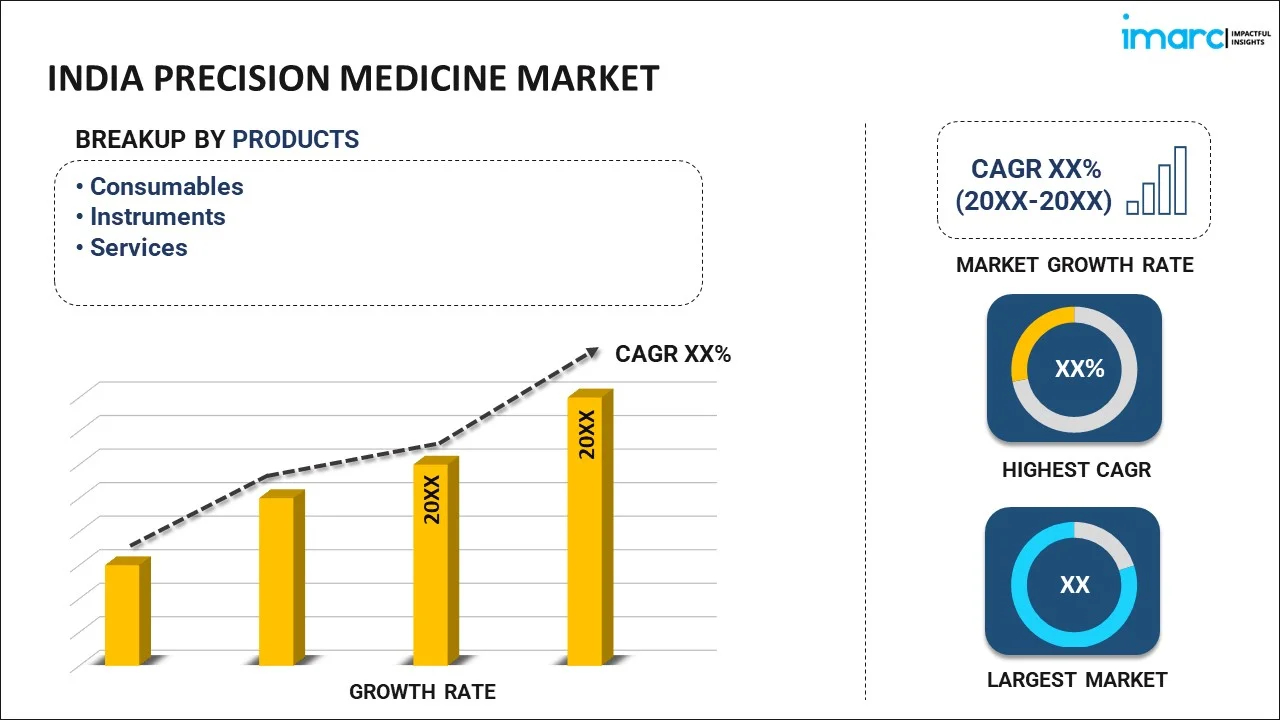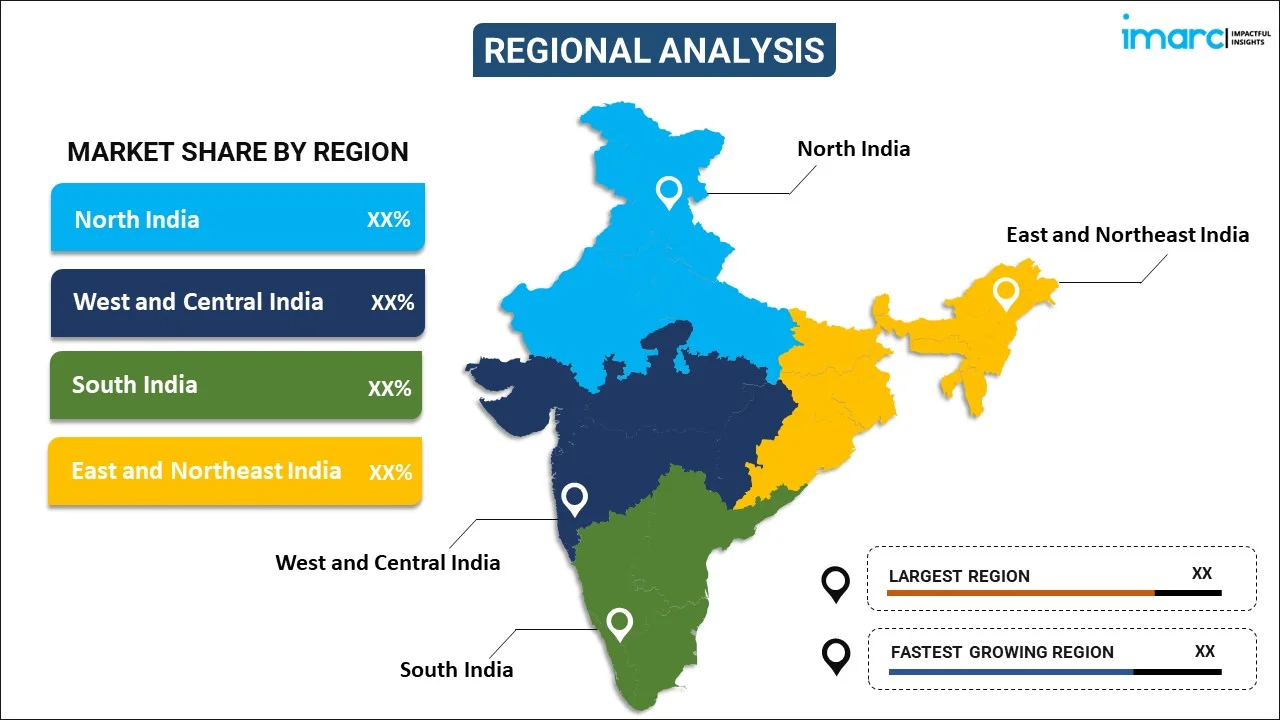
India Precision Medicine Market Report by Product (Consumables, Instruments, Services), Technology (Big Data Analytics, Bioinformatics, Gene Sequencing, Drug Discovery, Companion Diagnostics, and Others), Application (Oncology, Central Nervous System (CNS), Immunology, Respiratory Medicine, Infections, and Others), End User (Hospitals and Clinics, Diagnostic Centers, Pharma and Biotech Companies, Healthcare IT Firms, and Others), and Region 2025-2033
Market Overview:
India precision medicine market size reached USD 2.4 Billion in 2024. Looking forward, IMARC Group expects the market to reach USD 6.5 Billion by 2033, exhibiting a growth rate (CAGR) of 11.8% during 2025-2033. The rising incidence of chronic diseases, such as cancer, cardiovascular disorders, and diabetes, which has increased the demand for more effective and targeted treatment options, is driving the market.
|
Report Attribute
|
Key Statistics
|
|---|---|
|
Base Year
|
2024
|
|
Forecast Years
|
2025-2033
|
|
Historical Years
|
2019-2024
|
|
Market Size in 2024
|
USD 2.4 Billion |
|
Market Forecast in 2033
|
USD 6.5 Billion |
| Market Growth Rate 2025-2033 | 11.8% |
Precision medicine is a groundbreaking approach to healthcare that tailors medical treatment and interventions to the unique characteristics of each individual. It involves analyzing a person's genetic makeup, lifestyle, and environmental factors to understand the underlying causes of diseases at a molecular level. By gaining insights into the specific genetic mutations or variations, healthcare providers can design personalized treatment plans that are more effective and have fewer side effects. Precision medicine aims to move away from the traditional one-size-fits-all model of healthcare and considers the diversity among patients. Advances in technology, such as genomic sequencing, enable researchers and clinicians to identify specific biomarkers associated with diseases, leading to more targeted therapies. This individualized approach has the potential to revolutionize the prevention, diagnosis, and treatment of various conditions, ultimately improving patient outcomes and reducing healthcare costs.
India Precision Medicine Market Trends:
The precision medicine market in India is experiencing exponential growth due to several key drivers. Firstly, advancements in genomics and molecular biology have significantly expanded the understanding of the genetic basis of diseases, propelling the demand for personalized therapies. As a result, pharmaceutical and biotechnology companies are heavily investing in R&D to create targeted treatments, driving market expansion. Moreover, the increasing prevalence of chronic diseases and cancer has intensified the need for more effective and tailored interventions. Precision medicine offers a promising solution by identifying specific genetic mutations or biomarkers, enabling healthcare providers to deliver more precise and efficient treatments. This demand is further fueled by the rising awareness among both healthcare professionals and patients about the potential benefits of personalized medicine in improving treatment outcomes and reducing adverse effects. Additionally, the convergence of technological innovations, such as artificial intelligence and big data analytics, has played a pivotal role in advancing precision medicine. These technologies enable the analysis of vast datasets, facilitating the identification of patterns and correlations crucial for personalized treatment strategies. The growing integration of these technologies into healthcare systems is propelling the precision medicine market forward, promising a future where medical interventions are truly tailored to the unique genetic makeup of each individual.
India Precision Medicine Market Segmentation:
IMARC Group provides an analysis of the key trends in each segment of the market, along with forecasts at the country level for 2025-2033. Our report has categorized the market based on product, technology, application, and end user.
Product Insights:

- Consumables
- Instruments
- Services
The report has provided a detailed breakup and analysis of the market based on the product. This includes consumables, instruments, and services.
Technology Insights:
- Big Data Analytics
- Bioinformatics
- Gene Sequencing
- Drug Discovery
- Companion Diagnostics
- Others
A detailed breakup and analysis of the market based on the technology have also been provided in the report. This includes big data analytics, bioinformatics, gene sequencing, drug discovery, companion diagnostics, and others.
Application Insights:
- Oncology
- Central Nervous System (CNS)
- Immunology
- Respiratory Medicine
- Infections
- Others
The report has provided a detailed breakup and analysis of the market based on the application. This includes oncology, central nervous system (CNS), immunology, respiratory medicine, infections, and others.
End User Insights:
- Hospitals and Clinics
- Diagnostic Centers
- Pharma and Biotech Companies
- Healthcare IT Firms
- Others
A detailed breakup and analysis of the market based on the end user have also been provided in the report. This includes hospitals and clinics, diagnostic centers, pharma and biotech companies, healthcare IT firms, and others.
Regional Insights:

- North India
- West and Central India
- South India
- East and Northeast India
The report has also provided a comprehensive analysis of all the major regional markets, which include North India, West and Central India, South India, and East and Northeast India.
Competitive Landscape:
The market research report has also provided a comprehensive analysis of the competitive landscape in the market. Competitive analysis such as market structure, key player positioning, top winning strategies, competitive dashboard, and company evaluation quadrant has been covered in the report. Also, detailed profiles of all major companies have been provided.
India Precision Medicine Market Report Coverage:
| Report Features | Details |
|---|---|
| Base Year of the Analysis | 2024 |
| Historical Period | 2019-2024 |
| Forecast Period | 2025-2033 |
| Units | Billion USD |
| Scope of the Report | Exploration of Historical Trends and Market Outlook, Industry Catalysts and Challenges, Segment-Wise Historical and Future Market Assessment:
|
| Products Covered | Consumables, Instruments, Services |
| Technologies Covered | Big Data Analytics, Bioinformatics, Gene Sequencing, Drug Discovery, Companion Diagnostics, Others |
| Applications Covered | Oncology, Central Nervous System (CNS), Immunology, Respiratory Medicine, Infections, Others |
| End Users Covered | Hospitals and Clinics, Diagnostic Centers, Pharma and Biotech Companies, Healthcare IT Firms, Others |
| Regions Covered | North India, West and Central India, South India, East and Northeast India |
| Customization Scope | 10% Free Customization |
| Post-Sale Analyst Support | 10-12 Weeks |
| Delivery Format | PDF and Excel through Email (We can also provide the editable version of the report in PPT/Word format on special request) |
Key Questions Answered in This Report:
- How has the India precision medicine market performed so far and how will it perform in the coming years?
- What has been the impact of COVID-19 on the India precision medicine market?
- What is the breakup of the India precision medicine market on the basis of product?
- What is the breakup of the India precision medicine market on the basis of technology?
- What is the breakup of the India precision medicine market on the basis of application?
- What is the breakup of the India precision medicine market on the basis of end user?
- What are the various stages in the value chain of the India precision medicine market?
- What are the key driving factors and challenges in the India precision medicine?
- What is the structure of the India precision medicine market and who are the key players?
- What is the degree of competition in the India precision medicine market?
Key Benefits for Stakeholders:
- IMARC’s industry report offers a comprehensive quantitative analysis of various market segments, historical and current market trends, market forecasts, and dynamics of the India precision medicine market from 2019-2033.
- The research report provides the latest information on the market drivers, challenges, and opportunities in the India precision medicine market.
- Porter's five forces analysis assist stakeholders in assessing the impact of new entrants, competitive rivalry, supplier power, buyer power, and the threat of substitution. It helps stakeholders to analyze the level of competition within the India precision medicine industry and its attractiveness.
- Competitive landscape allows stakeholders to understand their competitive environment and provides an insight into the current positions of key players in the market.
Need more help?
- Speak to our experienced analysts for insights on the current market scenarios.
- Include additional segments and countries to customize the report as per your requirement.
- Gain an unparalleled competitive advantage in your domain by understanding how to utilize the report and positively impacting your operations and revenue.
- For further assistance, please connect with our analysts.
 Inquire Before Buying
Inquire Before Buying
 Speak to an Analyst
Speak to an Analyst
 Request Brochure
Request Brochure
 Request Customization
Request Customization




.webp)




.webp)












